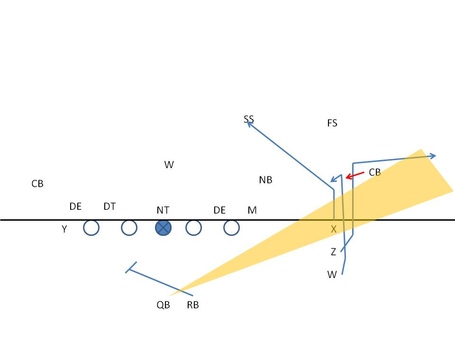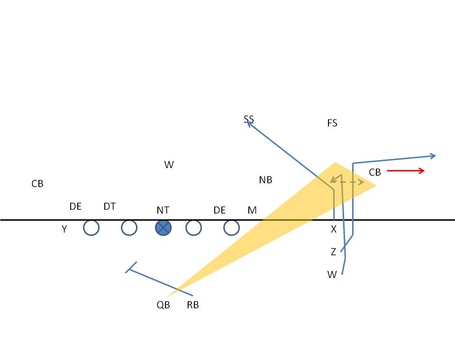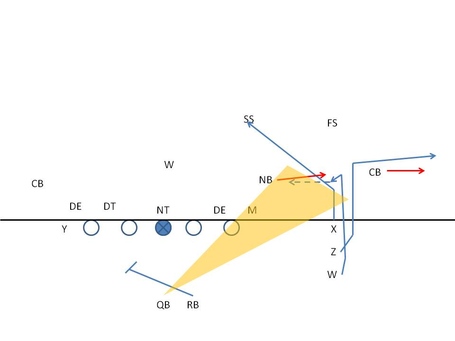Film Review: How OSU Stopped Michigan's 2-pt Conversion
Last time we looked at the theory of the 2 point conversion, triangle concept. In this part we will go deeper and figure out why it wasn't successful and what were some other potential plays for Michigan to run out of the same formation.
Video Recap
How OSU Stopped It
Let's look at what this means: if Gallon gets outside, the two underneath defenders must commit to a direction.
Flat defender stays in:
Flat defender goes out, underneath defender stays inside:
Both commit outside:
It becomes extremely difficult for both to cover all that room for such a short throw. In fact, it's next to impossible. That's because the underneath defender is basically put in a no win position. He must commit one way or the other, and Dileo can either work against that action across his body, or Gardner can throw Dileo open to the outside. This play is hijacked by the well timed jam of the flat defender.
What this does is it gives DG a bad read. The window is tight, because Gallon hasn't "occupied" his defender. Because he doesn't occupy him enough to draw him out (it also doesn't allow him to commit inside, he doesn't have to commit at all rather), DG reads to throw at his chest as it reads as if that flat CB has coverage responsibility on Dileo. DG doesn't see the underneath defender because he reads the flat defender as his key for the throw to Dileo within that tight window. He's also forced to read this quickly because the pressure is getting home.
Video Recap
* * * * * * *
Alright, now let's look at the coverage. This is your standard cover 2. A triangle concept should work perfectly. But, OSU does roll the backside safety. He takes the slant route. Open field is between levels for the Z-receiver, so he has to get upfield of the CB and then work outside. The CB though, does a nice job (in the context of this play, I'll explain more later), to get his arms out and really re-direct Gallon. This CB has outside leverage and inside help, his goal is to tighten that window by redirecting the receiver inside, and typically, if he does that, it will help him and the defense in coverage. This redirect shouldn't happen so easily here, but the CB does his job, and it takes Gallon off track for longer than it should. Because of this, Gallon doesn't draw his flat defender outside. This is the zone-beater remember, they are running and inside-out on the flat defender here with the horizontal stretch. But the redirect makes it so the CB never has to break to the flat (with the WR even horizontally with the safety and 6 yards shallower, that safety could not defend that route alone). The redirect makes it so neither underneath DB must commit.Let's look at what this means: if Gallon gets outside, the two underneath defenders must commit to a direction.
Flat defender stays in:
Flat defender goes out, underneath defender stays inside:
Both commit outside:
It becomes extremely difficult for both to cover all that room for such a short throw. In fact, it's next to impossible. That's because the underneath defender is basically put in a no win position. He must commit one way or the other, and Dileo can either work against that action across his body, or Gardner can throw Dileo open to the outside. This play is hijacked by the well timed jam of the flat defender.
What this does is it gives DG a bad read. The window is tight, because Gallon hasn't "occupied" his defender. Because he doesn't occupy him enough to draw him out (it also doesn't allow him to commit inside, he doesn't have to commit at all rather), DG reads to throw at his chest as it reads as if that flat CB has coverage responsibility on Dileo. DG doesn't see the underneath defender because he reads the flat defender as his key for the throw to Dileo within that tight window. He's also forced to read this quickly because the pressure is getting home.
* * * * * * *
To read much more on this play, including how OSU adjusted to stop any throw back and roll out from Gardner, as well as the other options that were available out of the stack formation, follow the link to Maize n Brew






aaarrrrggggghhhh - Kalis' man rushes everything.
ReplyDeleteplease explain to me why you don't have a problem with this play call or the failure to check at the line of scrimmage.
ReplyDeletewe come out in a trips stack to the right. osu responds by putting four defensive backs in the area, the SS on funchess, which is a mismatch. the WILL could help the SS, but he doesn't. instead he's kind of in no-man's land, covering the underneath, potentially with the assignment to spy gardner of the RB. but the result is that OSU has 4 defensive backs to cover 3 receivers.
on the left side we have a TE. he stays in to block. the RB also moves to the left side. neither the TE nor the RB are of any help if the MIKE rushes, which he does. the corner of the left side has rolled up to the LOS. he seems to have contain and ends up falling down anyway. the net is that osu has five rushers for six blockers. the MIKE's rush seems to confuse kalis, who lets bosa straight through. having the TE and the RB on the left makes sense to guard against the corner from blitzing, and indeed the TE engages in the rush, but now the RB is totally useless.
the net is that M ends up playing 11 (osu) on 10 football. not a recipe for success when the back of the endzone operationally acts as a 12th defender. putting a receiver to the left or leaking the RB out to the left potentially gives M one-on-one coverage. the actual play call gives M no advantages. the play could work if you're looking to shoot downfield because the DBs wouldn't be able to cover the WRs for a long enough period. but that's where the back of the endzone helps - it allows the MIKE to blitz on the side where OSU has the numerical advantage, which ultimately is what scuttled the play. this is what people mean when they say borges doesn't put his players in a position to succeed.
No one "has Funchess" as you're pointing out. It's a cover 2 match. The SS has the first guy that goes high and inside, whomever that is. It happens to be Funchess, and that's who he takes. The NB takes the next guy coming inside, whoever that is, or will take whoever comes inside and short first. That is his match up. Because Funchess's initial release is downfield, he passes him off and looks at the next two receivers, if one breaks out, that's his man.
DeleteNow, the WILL has no intention of covering a route, he is very clearly spying Gardner and reading his eyes, as a spy is taught to do. OSU was going to put a spy on Gardner no matter what.
Now, talking about the blocking scheme. There are two potential rushers on the backside (DE and CB). You need to account for them with blockers (TE and RB, respectively). You're worrying about a MIKE blitzing that has two blockers accounting for him. They already have an extra blocker to that side, why would they leave a RB in to help there and leave a potential free rusher? And the reason they are sliding protection this way is two fold: 1) the RB motion is intended to hold the middle coverage; 2) they want immediate blockers to the playside to keep hands down and to make throwing lanes clearer and cleaner.
Now, sure, you can leak the RB, you can even run him in a route and try to pull that CB out, but what does that give you? If you're saying the RB is totally useless, then Roby is also totally useless for the defense. As is Roby, is waiting for the RB to leak out instead of blitzing in. You've negated OSU's best CB with the RB here, which sounds like a pretty good trade off. And I don't really believe leaking a RB out on Roby (who is occupied anyway) is really an advantage by any means and doesn't really give Michigan any advantage because DG still can't come back that direction unless it's his first read, which seems dubious.
Now, you talk 4 DBs for 3 WRs plus the back of the end zone. But that's going to happen regardless. The defense is going to add an extra defender to one side. You put 2 WRs out there, they'll put 3 DBs to field, it's the way it's going to be. And at the goal line, you don't have time, especially with this OL, to sit there and scan the field to both sides of the formation, so it makes sense to put as many options as you can to one side. If you put 2 on one side, you are just limiting your options and making the numerical advantage worse.
The things you're pointing out with the back of the end zone are going to happen with any pass play. The field is condensed, there are a limited number of route concepts you can run that work within that area and have multiple options. A triangle concept is the simplest and most effective way to actually get three reads to one side of the field. What other concept would you run here?
Now, they could check to a speed option play, although both players would be accounted for (DG = spy; RB = CB) and I'm sure OSU would adjust to that look. OSU has adjusted to this look, the best option is actually a QB draw, but DG is very clearly hurt and can't run. The rest is accounted for. This is one of the best options that Michigan has in this situation, as at worst it should leave 2 receivers singled up in man with rub route concepts, or it should over load a zone (the outside flat) by splitting the coverage.
I'm curious at to what you would call that you wouldn't have a problem with